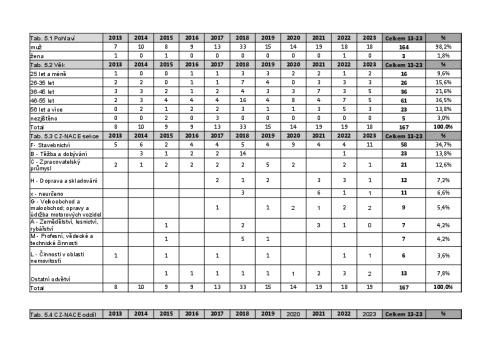Gender and age of the worker affected by an occupational injury – Table 5.1, Table 5.2, Chart 5.2
Workers who suffered fatal occupational injuries were overwhelmingly male (with less than 2% of fatal workplace accidents involving women during the monitored period). The dominant age category is 46–55 years, followed by 36–45 years, these two together comprise more than 50% of all fatal occupational injuries of foreigners. Young workers under 25 contribute less than 10% to fatal occupational injuries.
Main activity (CZ-NACE) in which a fatal occupational injury occurred – Table 5.3, Table 5.4, Chart 5.3, Chart 5.4
The most frequent sector of CZ-NACE in which a fatal occupational injury of a foreigner was reported in the monitored period was F – Construction (almost 35% of fatal occupational injuries). This is followed by sector B – Mining and quarrying, C – Manufacturing and H – Transport and storage. These 4 sectors comprise almost 70% of all fatal occupational injuries during the monitored period. Other sectors of CZ-NACE are represented to a lesser extent. From the point of view of a more detailed division into CZ-NACE sections, the most common sections are 41 – Construction of buildings, 43 – Specialized construction activities and 05 – Mining and treatment of hard coal and brown coal.
Activity in which a fatal occupational injury occurred – Table 5.5, Chart 5.5
The activity with the highest percentage representation is "Handling, manipulation and processing of physical objects, living plants and animals," – a total of 33.5% of cases. This is followed by activities "Walking" and "Transport of goods".
Source of a fatal occupational injury – Table 5.6, Chart 5.6
Buildings, structures, surfaces above ground level (both inside and outside) were the most common source of fatal occupational injuries in the monitored period, in 22.8% of cases. In terms of percentage representation, the next sources are materials, objects, products, components, machinery, and vehicles, fragments, and dust (18%), followed by land vehicles (12%) and physical phenomena and natural elements (10.8%).
Cause of fatal occupational injuries (why the injury occurred) – Table 5.7, Chart 5.7
In more than 50% of cases, a miscalculated or underestimated risk is cited as the cause of a fatal occupational injury. Long-term statistics show that this cause is most often mentioned by employers in the injury records. The cause was not identified in almost 17% of cases. The use of unsafe procedures or work practices, including acting without authorization, violating prohibitions, or lingering in danger zones, was cited as the cause in 12.6% of cases.
Classification of the occupation of a worker affected by a fatal occupational injury according to CZ-ISCO/KZAM– Tab. 5.8, Chart 5.8
In almost 30% of cases, the occupation was classified as Craftsmen and related skilled workers in construction (excluding electricians). In 14% the occupation is unknown. This is followed by the occupations Drivers and Mobile equipment operators and Laborers in mining, construction, manufacturing, transport, and Related fields. Both jobs were similarly recorded in 13.2% of cases.
Place of fatal occupational injury – Table 5.9, Chart 5.9
In one third of cases, the location of the fatal occupational injury was an industrial sector. Similarly, construction sites, opencast quarries, opencast mines were the site of fatal occupational injuries in almost 30% of cases. Public space (which also includes means of transport and areas permanently open to public transport) was the place of injury in 15.6% of cases.
Type of accident resulting in a fatal occupational injury – Table 5.10, Chart 5.10
The most common cause of fatal occupational injuries was a fall from a height, into a depth, or on a flat surface (27% of cases). This is followed by falling objects from a height (tipping onto a person) in 15.6% of cases, traffic accidents in 10.8%, and mining accidents in 9% of cases.
A model example of a fatal occupational injury of a foreigner
Based on the evaluation of data for the monitored period from 2013 to 2023, we can construct a model case of a typical fatal occupational injury of a foreigner:
- They are men aged 46–55 with Ukrainian nationality.
- The main activity (CZ-NACE) within which a fatal occupational injury occurred is Section F – Construction, Section 41 – Construction of buildings.
- The occupation of the affected person is classified (CZ-ISCO) as "Craftsmen and skilled workers in construction (excluding electricians)."
- The activity in which a fatal occupational injury occurred is "Handling, manipulation and processing of physical objects, living plants and animals".
- The source of an occupational injury was "Buildings, structures, surfaces above ground level (both inside and outside)".
- The place of an occupational injury was the industrial sector.
- The cause of the accident was a miscalculated or underestimated risk.
- The type of accident is classified as a fall of a person from a height/into a depth/on a flat surface.
